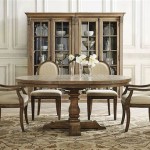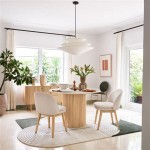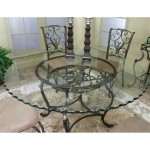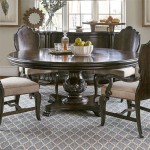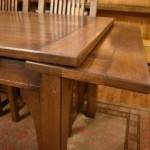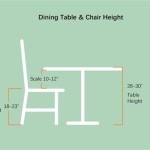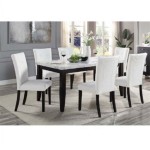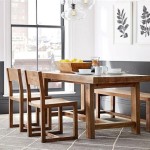Dining Room Table Bases: A Comprehensive Guide
The dining room table serves as a central gathering space within the home, facilitating meals, conversation, and shared experiences. While the tabletop itself often garners significant attention, the table base is an equally crucial element, influencing both the aesthetic appeal and the structural integrity of the overall piece. Selecting the appropriate base is essential for creating a functional and visually harmonious dining space. This article will explore the various types of dining room table bases available, highlighting their distinct characteristics, materials, and practical considerations.
Understanding the Importance of a Solid Table Base
A table base provides the necessary stability and support for the tabletop, ensuring it can withstand the weight of dishes, serving ware, and any pressure exerted during use. A poorly chosen base can result in a wobbly or unstable table, detracting from the dining experience and potentially posing a safety hazard. Beyond functionality, the base significantly contributes to the overall design aesthetic of the table. It can complement the tabletop material and style, or it can serve as a contrasting design element, adding visual interest to the room. The base also dictates the legroom available for diners, impacting comfort and accessibility. Factors such as the number of diners, the desired style, and the available space should all be carefully considered when selecting a table base.
The height of the table base is a critical factor. Standard dining table height ranges from 28 to 30 inches, measured from the floor to the top of the tabletop. The base itself will typically be slightly shorter to accommodate the thickness of the tabletop. Ensure the chosen base allows for comfortable legroom and aligns with standard dining chair heights. Furthermore, the positioning of the base elements is important. Legs placed too close together can limit seating capacity, while legs positioned too far apart may compromise stability. The base should be proportionally sized to the tabletop; a small base supporting a large tabletop will appear visually unbalanced and may lack sufficient support.
The material of the table base also contributes to its overall durability and longevity. Metal bases, such as steel or cast iron, offer excellent strength and stability, making them suitable for supporting heavier tabletops. Wood bases provide a warm and traditional aesthetic and can be crafted from various hardwoods, each offering distinct characteristics in terms of grain and color. Other materials, such as concrete or acrylic, offer unique design possibilities and can be incorporated to create contemporary and visually striking dining tables.
Exploring Different Types of Dining Room Table Bases
The market offers a wide array of dining room table base designs, each with its unique features and suitability for different styles and spaces. Understanding the distinctions between these types is crucial for making an informed decision.
Four-Legged Bases: This is the most common and traditional type of dining table base. Four legs, typically positioned at the corners of the tabletop, provide a stable and balanced support system. Four-legged bases are versatile and can be adapted to various styles, from classic to contemporary. The design of the legs themselves can vary significantly, ranging from simple straight legs to more ornate, turned legs with intricate details. The material of the legs can also contribute to the overall aesthetic, with wooden legs offering a more traditional feel and metal legs providing a more modern look.
The placement and angle of the legs are important considerations. Legs that splay outwards slightly can improve stability, especially for larger or heavier tabletops. However, widely splayed legs can also take up more floor space and potentially obstruct traffic flow around the table. Straight legs offer a cleaner, more streamlined look, but they may require additional bracing or reinforcement to ensure adequate support. The thickness and profile of the legs also contribute to the overall visual impact. Thicker legs create a more substantial and grounded feel, while thinner legs offer a lighter and more delicate appearance.
Pedestal Bases: A pedestal base features a single central support column, often resting on a wider base or foot. Pedestal bases are particularly well-suited for round or oval tabletops, as they provide unobstructed legroom around the entire perimeter of the table. This type of base is also a good choice for smaller dining spaces, as it minimizes the visual clutter of multiple legs. Pedestal bases can be crafted from various materials, including wood, metal, and concrete, and can be designed with a variety of shapes and details, from simple cylindrical columns to more ornate, sculpted designs.
The stability of a pedestal base is dependent on the size and weight of the base, as well as the overall design of the column. A wider and heavier base will provide greater stability, especially for larger tabletops. The shape and construction of the column also play a role. A solid column will be more stable than a hollow one, and a column with internal bracing will offer greater resistance to flexing or bending. The connection between the column and the tabletop is also crucial. A secure and well-engineered connection will prevent the tabletop from wobbling or shifting. Pedestal bases require careful consideration of weight distribution to prevent tipping, especially with uneven loading.
Trestle Bases: A trestle base consists of two or more vertical supports, connected by a horizontal beam or stretcher. Trestle bases are often associated with rustic or farmhouse styles, and they provide a sturdy and visually interesting support system. Trestle bases are particularly well-suited for longer, rectangular tabletops, as they distribute the weight evenly across the length of the table. The design of the trestles can vary significantly, from simple A-frame structures to more elaborate designs with curved or angled supports.
The stability of a trestle base is dependent on the strength and rigidity of the supports and the stretcher. The supports should be made from a durable material, such as solid wood or metal, and they should be securely connected to the tabletop. The stretcher should also be made from a strong material, and it should be positioned at a height that provides ample legroom for diners. The feet of the trestles should be designed to prevent slippage and to distribute the weight evenly across the floor. Trestle bases can sometimes limit legroom at the ends of the table, depending on the design of the trestles. The distance between the trestles should be carefully considered to ensure adequate support for the tabletop.
X-Bases: An X-base features two legs that cross each other, forming an "X" shape. This design provides a visually striking and modern aesthetic. X-bases can be made from metal, wood, or a combination of both, and they are often used with round or square tabletops. The intersection point of the X-legs is typically located near the center of the table, providing a stable support point.
The strength and stability of an X-base depend on the materials used and the quality of the construction. Metal X-bases are generally more robust than wood X-bases, but wood X-bases can be reinforced with metal hardware to improve their strength. The angle of the X-legs also affects the stability of the base. A steeper angle provides greater stability, but it also reduces the amount of legroom available. The feet of the X-legs should be designed to prevent slippage and to distribute the weight evenly across the floor. X-bases can sometimes limit legroom, particularly for diners seated directly adjacent to the legs.
Materials Used in Dining Room Table Bases
The material of a dining room table base not only contributes to its aesthetic appeal but also significantly influences its durability, maintenance requirements, and overall cost.
Wood: Wood is a classic and versatile material for dining room table bases. It offers a warm and natural aesthetic, and it can be easily shaped and finished to complement a wide range of styles. Hardwoods, such as oak, maple, and walnut, are commonly used for wood table bases due to their strength and durability. Softwoods, such as pine, can also be used, but they may require more protection against dents and scratches. Wood bases can be stained, painted, or left natural to showcase the beauty of the wood grain. Wood bases require regular cleaning and may need to be refinished periodically to maintain their appearance. Exposure to excessive moisture or humidity can cause wood to warp or crack. Choosing a durable finish is important for protecting the wood from spills and stains.
Metal: Metal is a strong and durable material option for dining room table bases. Steel and cast iron are commonly used for metal table bases due to their high strength-to-weight ratio. Metal bases offer a sleek and modern aesthetic, and they can be powder-coated or painted in a variety of colors. Metal bases are generally resistant to scratches and dents, and they are easy to clean. However, some metals can rust if exposed to moisture, so it is important to choose a metal that is treated to resist corrosion. Metal bases can also be quite heavy, which can make them difficult to move. The joins in metal bases, particularly wrought iron, are prone to fatigue cracking over time.
Concrete: Concrete is a unique and increasingly popular material for dining room table bases. Concrete bases offer a contemporary and industrial aesthetic, and they can be cast in a variety of shapes and sizes. Concrete is a very durable material, but it is also quite heavy and can be prone to cracking if not properly reinforced. Concrete bases require sealing to protect them from stains and moisture. The porous nature of concrete means spills should be cleaned promptly to prevent staining.
Acrylic and Other Synthetics: Acrylic and other synthetic materials are gaining popularity for dining room table bases, offering a modern and often minimalist aesthetic. These materials are lightweight, durable, and can be molded into various shapes and colors. Acrylic bases are resistant to moisture and stains, making them easy to clean. However, they can be prone to scratching and may not be as strong as wood or metal bases. The impact resistance of some synthetic materials is low, with shattering a possible hazard.

Table Base 303 Namu 28h For Glass Dining Top Flowyline Design

Dining Table Base 302 Uilani Metal Heavy Duty Pedestal Flowyline

Pedestal Bases Massive Statement Piece

Abstract Style Metal Table Base Econ Welding

Table Base 306 Xerxes 28h Metal With X Shape Legs Flowyline

Table Base Dining Metal Handmade Furniture Modern Legs Xsavi 80 60 Etsy

V Column Dining Table Base Pathway Tables

Wishbone Dining Table Base Pathway Tables

Table Base 313 Summa 28h Metal Furniture Flowyline

Base Table Oak Smoked Stain Rectangular Standard 0002 160cm 90cm 3cm

